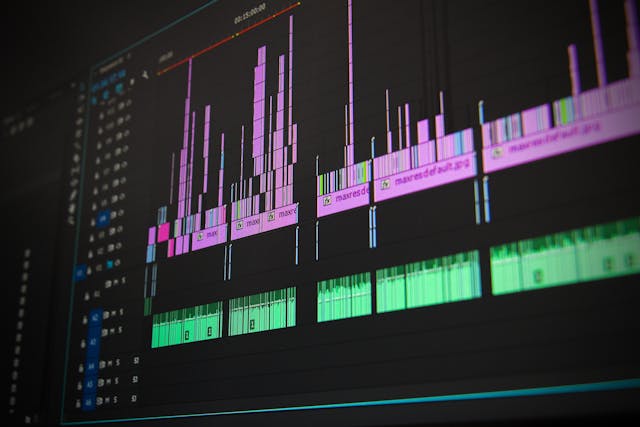The Art of Mixing and Mastering: How Professionals Perfect Audio Tracks
When you listen to a song on the radio, a streaming platform, or at a concert, what you hear is the result of a meticulous process behind the scenes. Two critical stages in this process—mixing and mastering—are what transform raw audio into a polished, professional track. These stages involve intricate technical skills and artistic decisions that ensure the music sounds its best. In this article, we’ll explore the art of mixing and mastering and why these processes are crucial for producing high-quality audio.

What Is Mixing?
Balancing the Elements
Mixing is the process of taking all the individual audio tracks from a recording (such as vocals, drums, guitar, and bass) and blending them together to create a cohesive sound. This stage focuses on balance, ensuring that each element of the song can be heard clearly and that nothing overpowers the rest of the mix.
The goal of mixing is to create a sonic landscape that is both harmonious and dynamic. A professional mix engineer uses various tools and techniques to shape the sound, including:
- Equalization (EQ): This adjusts the frequencies of each track to ensure that all the instruments fit together in the frequency spectrum. For example, reducing the bass frequencies on vocals helps them sit better with the bass guitar.
- Compression: Compression reduces the dynamic range between the loudest and softest parts of a track, making the overall mix sound more consistent. For instance, it can smooth out the volume fluctuations in a vocal performance or tighten up the sound of a drum kit.
- Reverb and Delay: These effects add space and depth to the mix, giving the music a sense of ambiance. Reverb simulates the reflections of sound in a room, while delay creates an echo effect. Both can make a track sound fuller and more immersive.
- Panning: This refers to placing the tracks in the stereo field, from left to right. For example, placing a guitar slightly to the left and a piano slightly to the right helps create a sense of balance and width in the mix.
- Volume Levels: Adjusting the volume of each track to ensure that no instrument is too quiet or too loud. For example, making sure the lead vocals sit prominently in the mix without drowning out the background music.
What Is Mastering?
Finalizing the Track for Distribution
Once a track is mixed, it enters the mastering stage. Mastering is the final step before a song is ready for distribution, whether on streaming platforms, CDs, or vinyl records. It’s the process of preparing the mixed audio for release by making it sound polished, consistent, and optimized for various playback systems.
Mastering focuses on a few key areas:
-
Level Adjustment: Mastering ensures the track's overall volume is balanced and consistent across all songs on an album or playlist. This is important because tracks that vary too much in volume can be jarring when played in sequence.
-
EQ and Frequency Adjustments: While mixing involves EQ for individual tracks, mastering involves making broad EQ adjustments to the entire mix. This helps to ensure the song sounds great on all devices, from high-end headphones to car speakers.
-
Compression and Limiting: In mastering, compression and limiting are used to increase the perceived loudness of a track without causing distortion. This makes the song sound louder and more impactful, which is crucial for modern music, as people tend to expect louder tracks, especially when listening on mobile devices.
-
Stereo Enhancement: This can involve subtle adjustments to the stereo image of the track, ensuring that it sounds well-balanced across different listening environments.
-
Creating the Final Master: The mastering engineer creates the final version of the track, ensuring it is ready for various formats (digital, vinyl, CD) and that it maintains a consistent sound across multiple platforms.
The Role of a Mixing Engineer
The Creative Vision
While both mixing and mastering require technical skill, the role of a mixing engineer is much more creative. A mixing engineer must have a keen ear for detail, as they are responsible for making artistic decisions about how each instrument should sound in the context of the song. This is where they get to bring their own creative vision into the music, making decisions like:
-
What tracks to emphasize: Should the bass be more prominent, or should the vocals take the spotlight? The mixing engineer decides what elements of the track are most important.
-
Creating space in the mix: It's important to make sure that all the instruments and vocals have room to breathe, so they don't fight for attention. This involves using EQ, panning, and effects creatively to carve out space for each sound.
-
Adding effects: Whether it's a reverb-drenched vocal or a delay effect on the guitar, the mixing engineer adds effects to enhance the song's mood and texture.
The Role of a Mastering Engineer
The Technical Perfectionist
While the mixing engineer focuses on the artistic aspects of the track, the mastering engineer is the technical perfectionist who ensures the track sounds as good as possible on every playback system. The mastering engineer is responsible for:
-
Polishing the track: They fine-tune the mix to make it sound its best, regardless of the medium or device on which it will be played.
-
Consistency across an album: If the song is part of an album, the mastering engineer ensures that all the tracks flow together seamlessly in terms of volume, EQ, and sound quality.
-
Preparing files for distribution: The mastering engineer exports the final track in the proper format and ensures it meets industry standards, whether it’s for digital release, vinyl, or CD.
Tools and Software Used in Mixing and Mastering
Both mixing and mastering require a variety of software tools and hardware to get the job done. Some of the most commonly used digital audio workstations (DAWs) and plugins in the industry include:
- DAWs: Popular DAWs for mixing include Pro Tools, Ableton Live, Logic Pro, and FL Studio. These programs provide the platform for recording, editing, and mixing audio.
- EQ Plugins: Tools like Waves EQ, FabFilter Pro-Q, and Universal Audio’s EQs are commonly used to adjust the frequencies of individual tracks or the entire mix.
- Compressor Plugins: For compression, tools like Waves SSL G-Master Buss Compressor, FabFilter Pro-C, and iZotope Ozone are favorites among professionals.
- Limiter Plugins: In the mastering phase, tools like iZotope Ozone Maximizer and Waves L2 Ultramaximizer are used to control the track’s final loudness without causing distortion.
- Reverb and Delay Plugins: Programs like Valhalla DSP, Soundtoys, and Lexicon Reverb are used to add spatial effects and depth to the mix.

Why Mixing and Mastering Matter
The Difference Between Good and Great Music
Both mixing and mastering are vital to making a song sound professional and ready for release. Without a good mix, a song can feel unbalanced or chaotic, and without proper mastering, it might lack the clarity, punch, and consistency that listeners expect.
Professional mixing and mastering ensure that the song will sound great on a variety of devices, from high-end headphones to car speakers and everything in between. It’s the final step in turning an idea into a polished, market-ready track.
Final Thoughts
Mixing and mastering are both complex, highly specialized skills that require years of practice and expertise. Mixing brings together the creative vision and technical know-how to balance all the elements of a song, while mastering ensures that the track is ready for distribution and will sound its best in any environment. Both processes are essential in taking a raw audio recording and transforming it into a polished, professional track that is ready for the world to hear. Whether you're a musician, producer, or simply a music lover, understanding these processes helps you appreciate the artistry behind every song you hear.
Why Mixing and Mastering Matter
The Difference Between Good and Great Music
Both mixing and mastering are vital to making a song sound professional and ready for release. Without a good mix, a song can feel unbalanced or chaotic, and without proper mastering, it might lack the clarity, punch, and consistency that listeners expect.
Professional mixing and mastering ensure that the song will sound great on a variety of devices, from high-end headphones to car speakers and everything in between. It’s the final step in turning an idea into a polished, market-ready track.
Final Thoughts
Mixing and mastering are both complex, highly specialized skills that require years of practice and expertise. Mixing brings together the creative vision and technical know-how to balance all the elements of a song, while mastering ensures that the track is ready for distribution and will sound its best in any environment. Both processes are essential in taking a raw audio recording and transforming it into a polished, professional track that is ready for the world to hear. Whether you're a musician, producer, or simply a music lover, understanding these processes helps you appreciate the artistry behind every song you hear.












